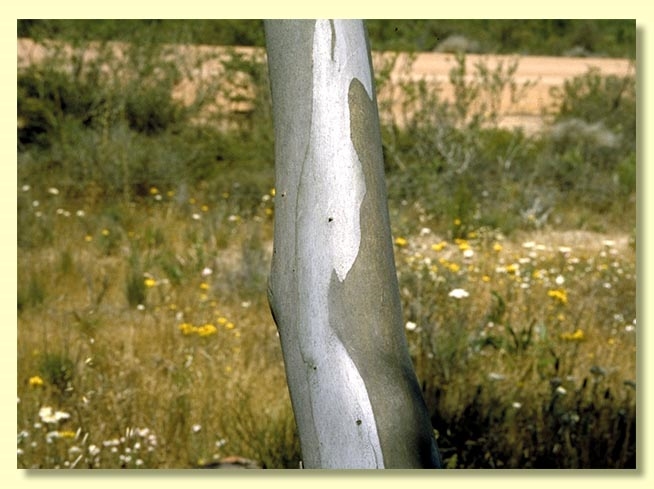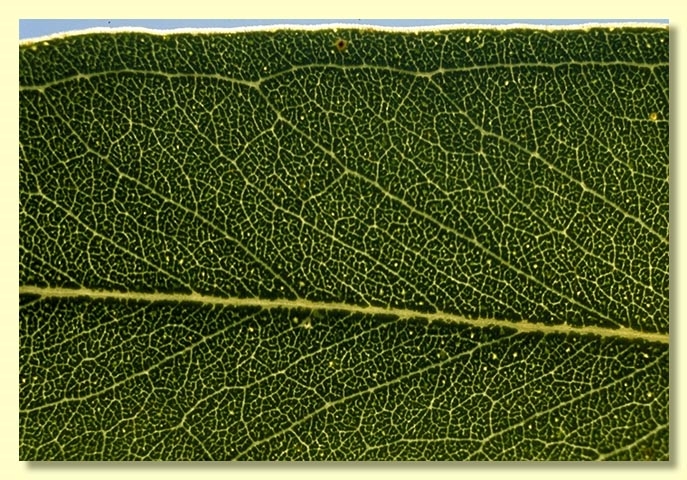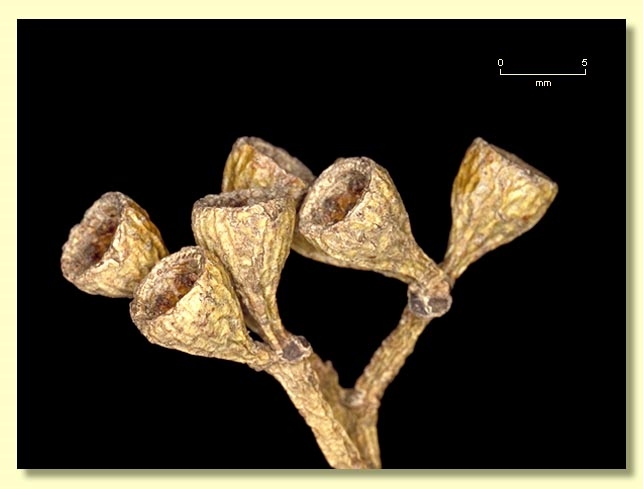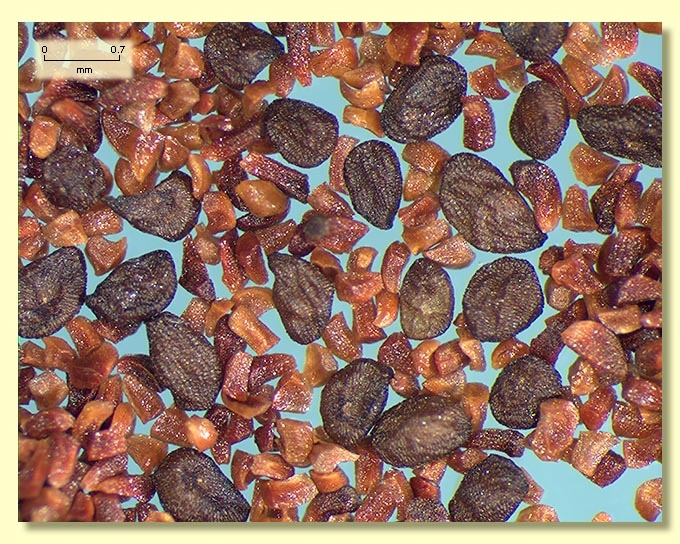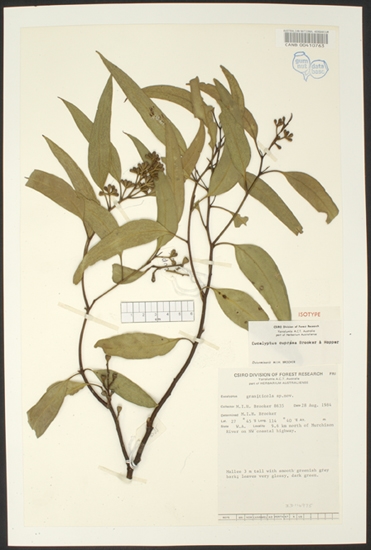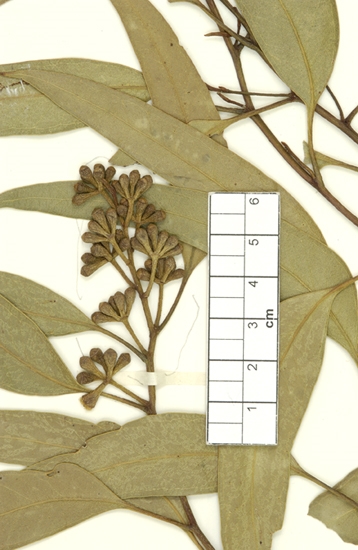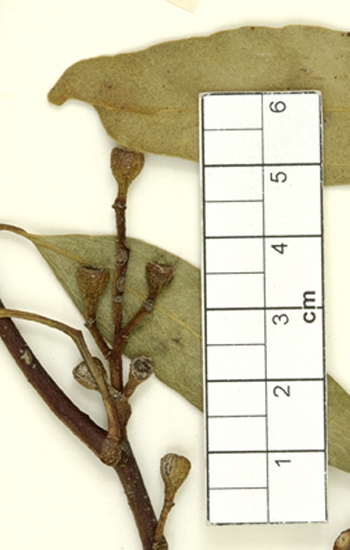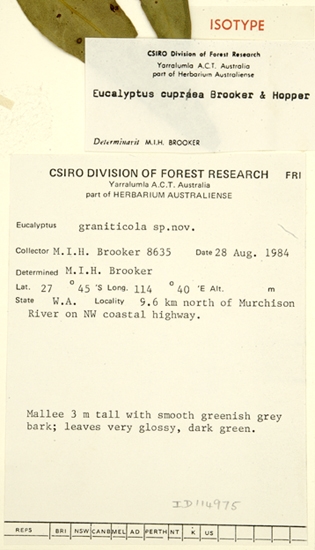Euclid - Online edition
Eucalyptus cuprea
Eucalyptus | Symphyomyrtus | Adnataria | Apicales | Buxeales | Amissae
Bark rough for up to 1.5 m of trunk, light grey flaky box-type, smooth above, coppery to pale orange and grey.
Branchlets lacking oil glands in the pith.
Juvenile growth (coppice or field seedlings to 50 cm): stems square to rounded in cross-section; juvenile leaves always petiolate, alternate, ovate, 5.5–10 cm long, 3–6 cm wide, dull, grey-green.
Adult leaves alternate, petiole 1.2–2.5 cm long; blade lanceolate, 8–13.5 cm long, 1.2–2 cm wide, base tapering to petiole, margin entire, apex pointed, concolorous, glossy, green, side-veins at an acute or wider angle, reticulation dense, intramarginal vein remote from margin, oil glands few, irregular, intersectional.
Inflorescence terminal compound but often with some smaller compound inflorescences in the upper axils also, peduncles 0.5–1.5 cm long, buds 7 per umbel, pedicels 0.2–0.6 cm long. Mature buds obovoid to pyriform, ca 0.5 cm long, 0.3–0.4 cm wide, scar present, operculum usually rounded and apiculate, stamens inflexed, the outer filaments without anthers (staminodes), anthers more or less cuboid, adnate, sub-basifixed, dehiscing by subterminal pores, style long and straight, stigma blunt to scarcely pin-head shaped, locules 4 or 5, the placentae each with 4 vertical rows of ovules. Flowers creamy white.
Fruit pedicellate (pedicels 0.1–0.5 cm long), obconical to cupular, 0.4–0.7 cm long, 0.4–0.5(0.6) cm wide, disc descending vertically, valves 4 or 5, enclosed deeply.
Seeds brown, 0.5–1.5 mm long, ovoid to flattened-ovoid, dorsal surface clearly reticulate, hilum ventral.
Cultivated seedlings (measured at node 10): cotyledons reniform; stems square in cross-section; leaves always petiolate, opposite for 3 to 6 nodes then alternate, ovate, 5.5–9 cm long, 3–5.5 cm wide, dull, green to light blue-green.
Flowering time unknown.
A mallee endemic to Western Australia, known only from a few localities north and north-east of Geraldton in the Moresby Range and one north of the Murchison River. It occurs in small pure stands. The bark is rough box-type on the lower part of the stems or is rarely smooth to the base. The adult leaves are glossy green with the intramarginal vein well in from the edge.
Eucalyptus cuprea differs from E. absita in having greener, more ovate juvenile leaves (deltoid and blue in E. absita) and fruit with a vertically descending disc (more or less obliquely descending in E. absita). Flowering in E. cuprea is usually in springtime (autumn-winter in E. absita). E. lucasii is a predominantly smooth-barked species with dull, not glossy, adult leaves and inhabits more arid areas north from Laverton.
Eucalyptus cuprea belongs in Eucalyptus subgenus Symphyomyrtus section Adnataria (the boxes) because the buds have two opercula, ovules are in four rows, seeds are flattened-ovoid, cotyledons are reniform, and anthers are rigid (adnate) on the staminal filaments. Within section Adnataria, E. cuprea is part of a subgroup, series Buxeales, further distinguished by being partially rough-barked, having terminal inflorescences and buds that lose the outer operculum early. Most species in series Buxeales are found in south-eastern Australia, with only three occurring in Western Australia, viz. E. cuprea, E. absita and E. lucasii. All three have inflexed stamens the outermost of which are imperfect (staminodes), features separating them to some extent from the eastern species.
Eucalyptus cuprea is listed as "Endangered" under the Australian Government Environment Protection and Biodiversity Conservation Act 1999 (EPBC Act). Further information may be found at this web address:
http://www.environment.gov.au/cgi-bin/sprat/public/sprat.pl


